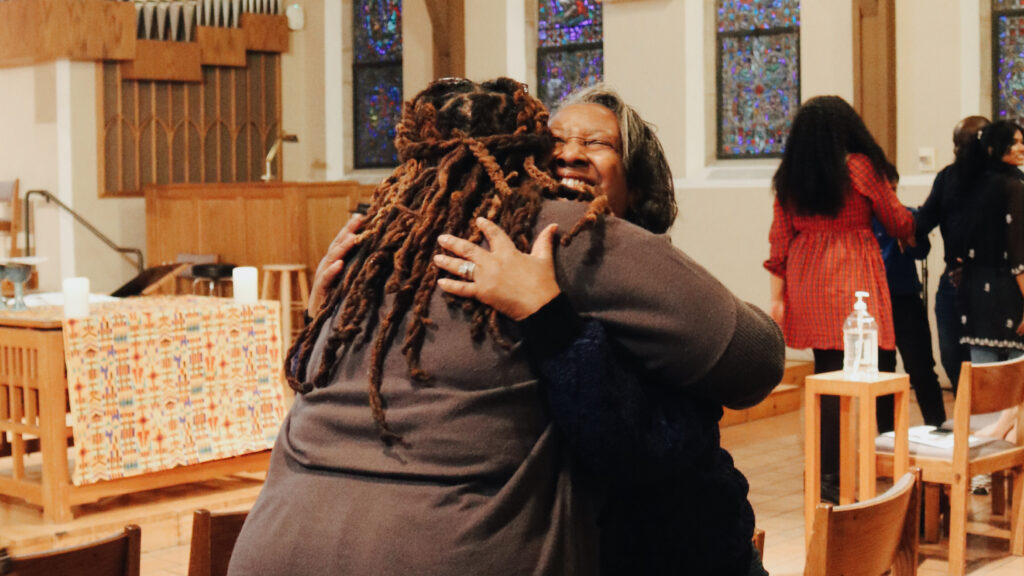Care is What We Do Together
April 3, 2024
A Conversation with Dr. Esther E. Acolatse

Western culture has a complicated relationship with grief. In Victorian England, elaborate mourning rituals were created, including elephantine six-foot veils designed to obscure if the mourner might be weeping. Historians report how the arsenic-laden crepe used for their construction led to headaches, skin irritation and even death, but the isolation it created around emotional pain is perhaps more damaging—and persists long after the veils, themselves, went out of fashion. Even today, many people still experience grief as something they must shoulder, for fear of becoming a burden on others. In that context, pastoral care often becomes a service offered by a religious professional; privatized and removed from the rest of the community.
This individualized experience of moving through grief could not be more different from traditional practices throughout Africa observes Dr. Esther Acolatse, Professor of Pastoral Theology and World Christianity, which prioritize the role of a community response. “My aunt just died,” she says, “People have been coming since Friday with things that might help you to bury your dead.” In the traditional Ghanaian funerary rituals, even washing the body of the deceased becomes a communal process. “Everybody brings part of what is used to wash,” she explains, “the immediate family will bring the sponge and soap, but they will levy everybody so that you feel you have offered substance to this mortuary rite.”
This collective approach in attending to the deceased’s loved ones ensures that no one moves through sorrow alone. “Communal caring practices underscore the connectedness of all human life,” Dr. Acolatse says, “To do care by looking at the individual is embedded in Western structures, and foreign to the African conception of how the community carries grief as a whole.” This difference in emphasis doesn’t just change how compassion is organized, it affects people’s emotional experience. “In the West people talk about stages of grief,” she explains, “but the way it functions here, there’s so much retelling of the story of how the loved one did his or her dying, with each new group of people that comes in. By the time the mortuary and funeral rites actually begin, you’ve already worked through the grief with the community.”
Christianity and the introduction of colonial values has changed some of these practices, Dr. Acolatse observes, but for the most part the ecclesial model has not supplemented traditional customs. Instead, the old ways and new sit—sometimes uneasily—side by side. One difference is that, traditionally, much of the collective care work was organized by women, a practice at odds with churches in which liturgical rituals are often led by men. “In church, you’ll find ways in which the woman subvert patriarchy—for example, by bursting into song in the middle of a sermon,” she says, “Say, the minister is preaching a sermon about Lazarus, since we are in grief. Suddenly the women’s group might start singing about Mary and Martha, and how they opened the way for Jesus to bring Lazarus out of the grave.”
Dr. Acolatse believes that Western conceptions of pastoral care can learn much from African communal care practices. “In more formal or professionalized understandings of pastoral care,” she explains, “we lose that communal ethos, and we lose the connectedness.” This is particularly devastating given how alone and isolated many people already feel. “The surgeon general is telling us that loneliness is one of the deadliest diseases in the Western world,” she notes, “close to the health risks from smoking.” Given this harrowing epidemic, the relief that connectedness can provide may be greater than anything an individual minister can do or say. “When bodies are in connection with other bodies,” Dr. Acolatse explains, “Healing is already beginning. Sustaining is already beginning. Reconciling is taking place in the interconnectedness because it is in the interconnectedness that we will quarrel, that we are real with one another. African ways of being already have inbuilt pastoral care.”
In thinking about this shift, Dr. Acolatse offers the practice of midwifing as a model to which ministers should look, when thinking about care. Partly because it pushes back against the image of a minister as a doctor ministering to the sick, towards an image of someone who works out of the community to provide partnership to the one who is suffering. It also changes the understanding of who is doing the labor. “When you midwife, you don’t do the work alone,” Dr. Acolatse says, “You do the work with the one who is birthing. And so, if it is me in my work of carrying pain and you midwife me through it, you’re not giving me something. You’re helping me do something.”
This not only rightfully returns a sense of agency to the person who is suffering, it also reduces the pressure on the minister. “There is something very freeing about thinking of pastoral care as midwifing, because I’m not the one in labor,” Dr. Acolatse laughs, “The fuller and harder work is done by you, not by the midwife.” Hopefully, by using this frame, churches can reemphasize the role of community in providing care and ease the burden felt by ministers, who often already shoulder too much. Throughout, it’s an opportunity to invite God to move in fresh ways. “God connects to us when we reconnect to people,” Dr. Acolatse observes, “In the midst of all this is the larger connectedness to the transcendent, that ties us to all human life with the reminder: We are never alone.”

